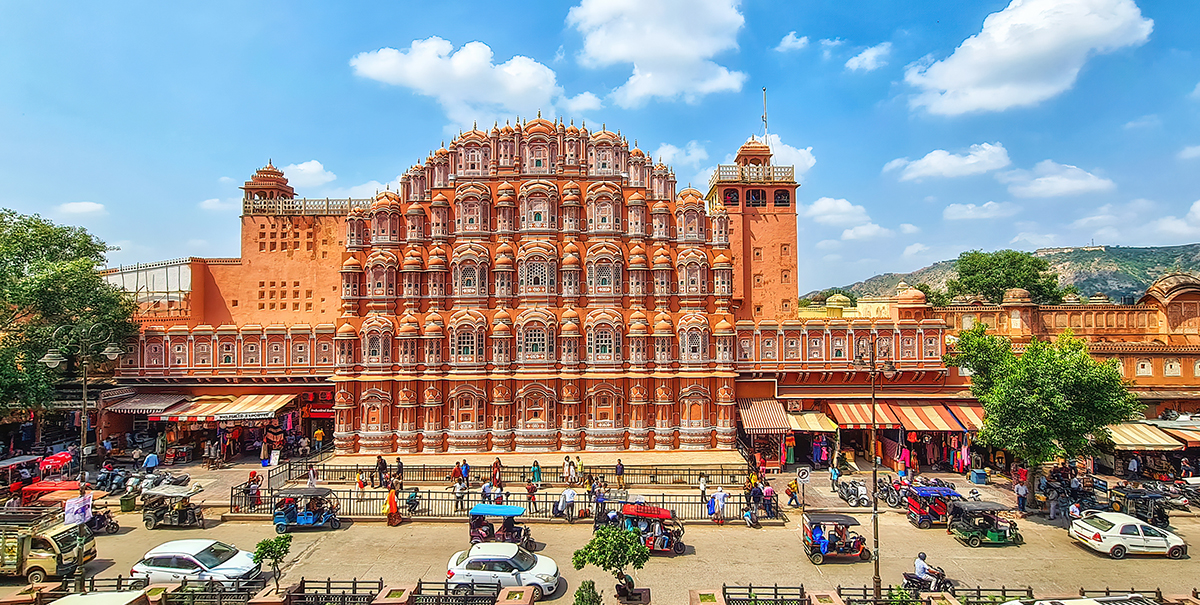Jaipur, the captivating “Pink City” of India, unfolds like a vibrant tapestry woven with rich history, architectural splendor, and bustling bazaars. Founded in 1727 by Maharaja Sawai Jai Singh II, the city was painted a distinct terracotta pink, symbolizing hospitality and reflecting the red sandstone used in its majestic buildings. Today, Jaipur stands as a popular tourist destination, enchanting visitors with its unique blend of heritage, cultural experiences, and vibrant energy.

Top Sights to See in Jaipur:
- Amber Fort: Perched atop a hill, Amber Fort, a UNESCO World Heritage Site, is a majestic palace complex showcasing Rajput architecture. Ascend the fort on an elephant for a truly regal experience and explore its courtyards, gardens, and breathtaking views of the city.
- Hawa Mahal (Palace of Winds): This iconic five-story facade boasts 953 intricately carved windows, designed to allow cool air to circulate within the palace. Admire the intricate details and capture stunning photographs against the backdrop of the bustling city.
- City Palace: A sprawling complex within the old city walls, the City Palace houses museums, courtyards, and gardens. Explore the Chandra Mahal, Mubarak Mahal, and Hawa Mahal within the complex, offering a glimpse into the opulent lifestyle of the Rajasthani royalty.
- Jal Mahal: This “Water Palace” sits amidst the Man Sagar Lake, creating a picturesque reflection and offering stunning views, especially at sunset. Take a boat ride to appreciate the palace’s beauty from a different perspective.
- Jantar Mantar: This astronomical observatory, built by Maharaja Jai Singh II, is a testament to his scientific prowess. Marvel at the sundials, armillary spheres, and other astronomical instruments used for timekeeping and celestial observations.
- Nahargarh Fort: Another hilltop fort offering panoramic views of the city, Nahargarh Fort served as a summer retreat for the Jaipur royalty. Explore its museums, lush gardens, and enjoy breathtaking sunsets from the viewing points.
- Hawa Mahal Bazaar: Immerse yourself in the vibrant chaos of this traditional market, overflowing with textiles, jewelry, spices, handicrafts, and souvenirs. Bargain with the vendors, soak in the colorful atmosphere, and discover unique treasures to take home.
Best Time to Visit Jaipur:

Jaipur experiences a hot and dry climate with distinct seasons. The best time to visit is from October to March, when the weather is pleasant with comfortable temperatures. Avoid the peak summer months (April to June) due to scorching heat, and the monsoon season (July to September) due to heavy rainfall that can disrupt travel plans.
Why is Jaipur Special?
Jaipur offers a unique combination of historical sites, cultural experiences, and vibrant energy, making it a truly special destination:
- Architectural Heritage: The city boasts a treasure trove of architectural marvels, showcasing Rajput, Mughal, and European influences. From the majestic forts and palaces to the intricate havelis (mansions), each building tells a story of the city’s rich past.
- Cultural Immersion: Immerse yourself in the vibrant culture of Rajasthan through traditional dance performances, puppet shows, and colorful festivals like Teej and Diwali. Witness the craftsmanship of local artisans, learn about the rich textile and jewelry traditions, and experience the warm hospitality of the people.
- Shopping Paradise: Jaipur is a shopper’s paradise, offering a wide variety of textiles, jewelry, handicrafts, and souvenirs. Explore the bustling bazaars, bargain with the vendors, and discover unique treasures to take home as a memento of your trip.
- Foodie Delights: Savor the delicious flavors of Rajasthani cuisine, known for its rich spices, aromatic curries, and delectable sweets. From street food stalls to renowned restaurants, indulge in delicacies like Dal Baati Churma, Laal Maas, and Ghewar.
Famous Food in Jaipur:
- Dal Baati Churma: A staple Rajasthani dish consisting of lentil soup (dal), wheat balls (baati), and a sweet mixture of ghee, flour, and jaggery (churma).
- Laal Maas: A fiery red meat curry cooked in yogurt and a blend of spices, known for its rich flavor and bold aroma.
- Ghewar: A sweet, ring-shaped pastry made with flour, ghee, and sugar, often soaked in sugar syrup and garnished with nuts and dried fruits.
- Pyaaz Kachori: A savory, deep-fried snack filled with a spicy onion stuffing, perfect as a breakfast treat or a mid-day pick-me-up.
- Mirchi Bada: Crispy pakoras made with green chilies and chickpea batter, offering a delightful combination of spice and heat.
- Malai Ghewar: A richer version of the classic Ghewar, featuring a creamy milk reduction layer for an extra indulgence.
- Rabdi: A thick, sweetened milk flavored with cardamom and saffron, typically served warm and enjoyed as a dessert or a drink.
- Mishti Doi: A sweet yogurt dessert similar to Greek yogurt, known for its smooth texture and subtle sweetness.
- Thandai: A refreshing summer drink made with milk, almonds, rosewater, and spices, offering a cool and flavorful experience.
Why is Jaipur Called the Paris of India?
While the title “Paris of India” is more aspirational than literal, Jaipur shares some similarities with the French capital:
- Planned City Layout: Both cities were planned and developed with wide avenues, gardens, and architectural coherence, offering a visually appealing and organized urban experience.
- Cultural Hub: Both cities are renowned for their vibrant art scenes, rich history, and cultural events, attracting artists, intellectuals, and tourists from around the world.
- Fashionable Flair: Jaipur boasts a thriving fashion industry and a growing reputation for contemporary design, while Paris remains a global fashion capital.
However, it’s important to remember that these comparisons are relative and should not overshadow the unique identity of Jaipur. Jaipur’s charm lies in its own blend of history, culture, and vibrant energy, making it a truly special and unforgettable destination for any traveler.




